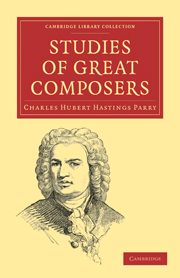V - MOZART
Published online by Cambridge University Press: 29 August 2010
Summary
Towards the middle of the eighteenth century most of those kinds of music which are familiar in the present day were pretty well established. The oratorio had been carried to a high pitch of perfection by Handel. The opera, in a style more modern than his, was becoming quite a common form of entertainment; and instrumental music, which is the most modern branch of the art, was progressing so well that the way to make overtures, symphonies, and sonatas was quite understood, and they were common enough to be appreciated by all men who had any pretensions to taste. The composers who had done the best work in the latter branch of art had been men of good abilities and honest purpose, but not of the highest order of genius. Among the Germans Hasse and Bach's sons and pupils stood highest; among Italians there were Galuppi and Paradisi, and the great school of violinists who followed the lead of Corelli, such as Tartini and Geminiani. Haydn, too, had by that time gone through the hardest and loneliest part of his career; and though he was not famous as yet, he had tried his hand in different lines, and had laid a good foundation, and was on the verge of receiving his first appointment as kapellmeister to Count Morzin, and of writing his first symphony.
In the picturesque town of Salzburg there was living at this time a most estimable man named. Leopold Mozart. He was the son of a bookbinder, and had taken to music as a profession, and pursued it with considerable success.
- Type
- Chapter
- Information
- Studies of Great Composers , pp. 119 - 155Publisher: Cambridge University PressPrint publication year: 2009First published in: 1887



